The Sustainable Hotel Environment: An Australian Industry Report
VerifiedAdded on 2021/06/17
|14
|3315
|42
Report
AI Summary
This report comprehensively analyzes the integration of environmental sustainability practices within the hotel industry, with a specific focus on the Australian market. It explores the evolution of 'green luxury,' examining how hotels are incorporating eco-friendly design, construction, and operational practices, including energy and water conservation. The report delves into the synergy between comfort, luxury, and environmental responsibility, showcasing innovative approaches like LEED certifications and the use of renewable energy. It also highlights specific examples like 'The Canopy Treehouses' and 'Oaks Cypress Lakes Resort'. Furthermore, the report addresses the arguments surrounding the co-existence of luxury and sustainability, considering potential conflicts between lavish amenities and environmental conservation. It concludes by emphasizing the growing trend of eco-tourism and the increasing importance of sustainable practices in the hotel industry, aiming to provide comfortable experiences while minimizing environmental impact.
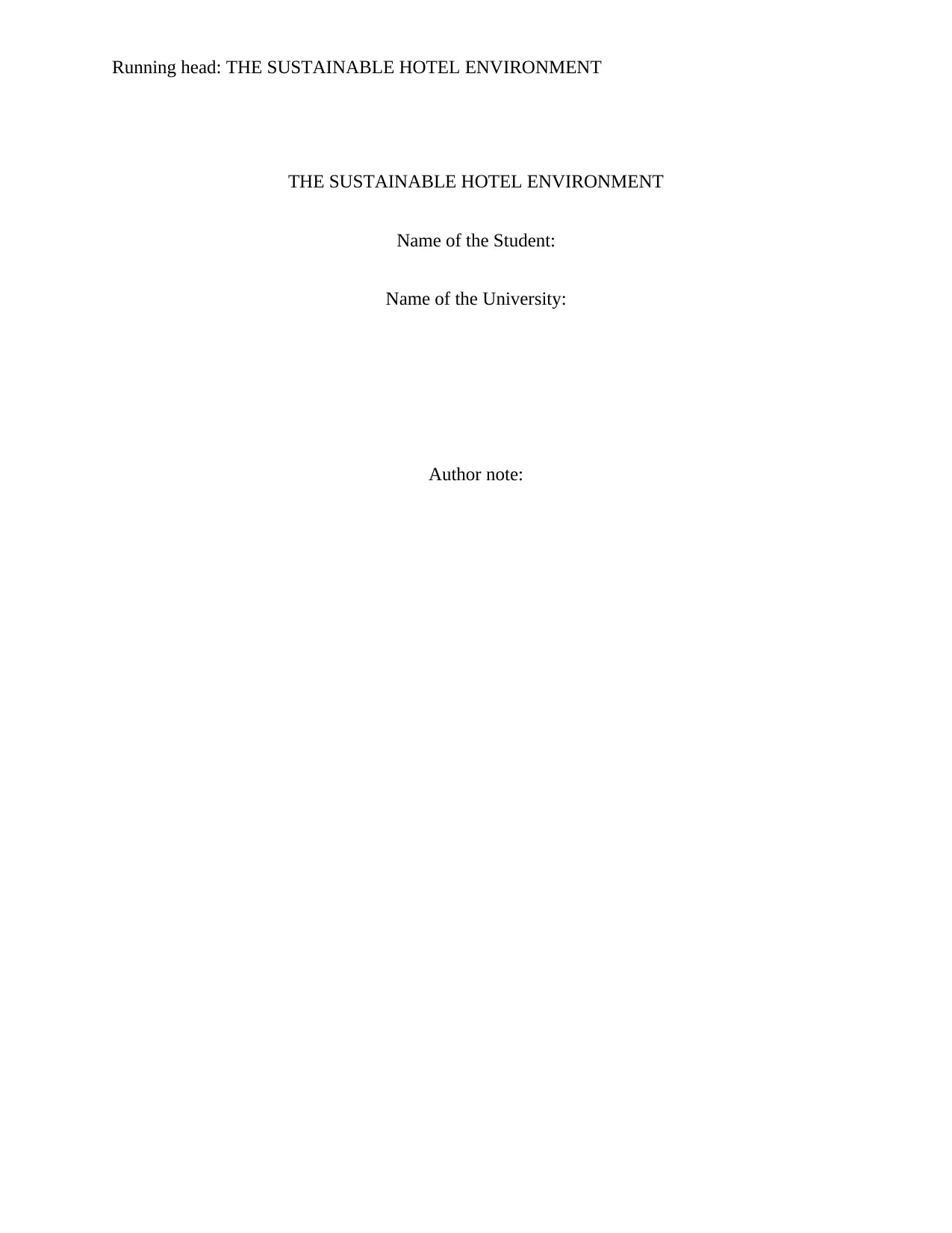
Running head: THE SUSTAINABLE HOTEL ENVIRONMENT
THE SUSTAINABLE HOTEL ENVIRONMENT
Name of the Student:
Name of the University:
Author note:
THE SUSTAINABLE HOTEL ENVIRONMENT
Name of the Student:
Name of the University:
Author note:
Paraphrase This Document
Need a fresh take? Get an instant paraphrase of this document with our AI Paraphraser
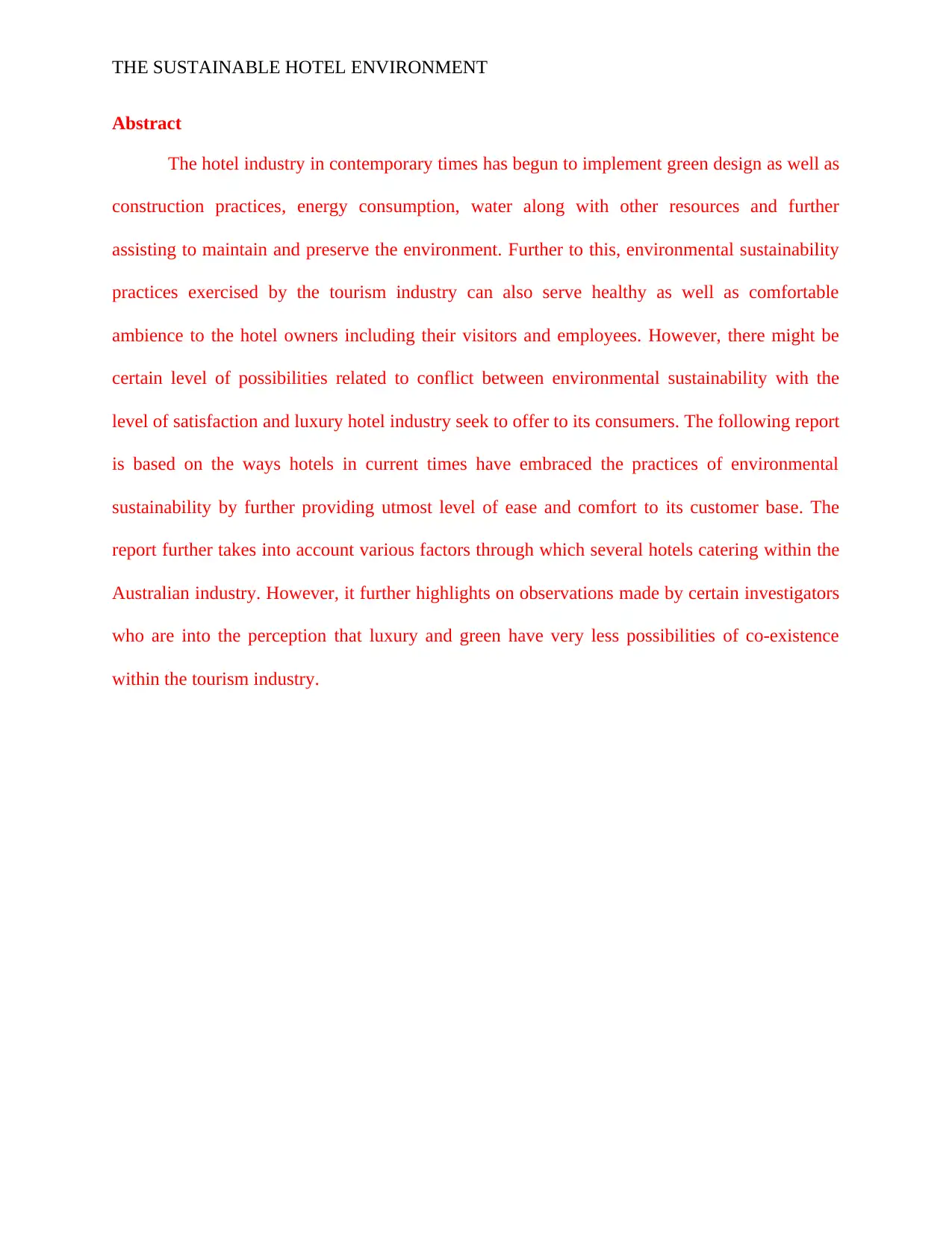
THE SUSTAINABLE HOTEL ENVIRONMENT
Abstract
The hotel industry in contemporary times has begun to implement green design as well as
construction practices, energy consumption, water along with other resources and further
assisting to maintain and preserve the environment. Further to this, environmental sustainability
practices exercised by the tourism industry can also serve healthy as well as comfortable
ambience to the hotel owners including their visitors and employees. However, there might be
certain level of possibilities related to conflict between environmental sustainability with the
level of satisfaction and luxury hotel industry seek to offer to its consumers. The following report
is based on the ways hotels in current times have embraced the practices of environmental
sustainability by further providing utmost level of ease and comfort to its customer base. The
report further takes into account various factors through which several hotels catering within the
Australian industry. However, it further highlights on observations made by certain investigators
who are into the perception that luxury and green have very less possibilities of co-existence
within the tourism industry.
Abstract
The hotel industry in contemporary times has begun to implement green design as well as
construction practices, energy consumption, water along with other resources and further
assisting to maintain and preserve the environment. Further to this, environmental sustainability
practices exercised by the tourism industry can also serve healthy as well as comfortable
ambience to the hotel owners including their visitors and employees. However, there might be
certain level of possibilities related to conflict between environmental sustainability with the
level of satisfaction and luxury hotel industry seek to offer to its consumers. The following report
is based on the ways hotels in current times have embraced the practices of environmental
sustainability by further providing utmost level of ease and comfort to its customer base. The
report further takes into account various factors through which several hotels catering within the
Australian industry. However, it further highlights on observations made by certain investigators
who are into the perception that luxury and green have very less possibilities of co-existence
within the tourism industry.
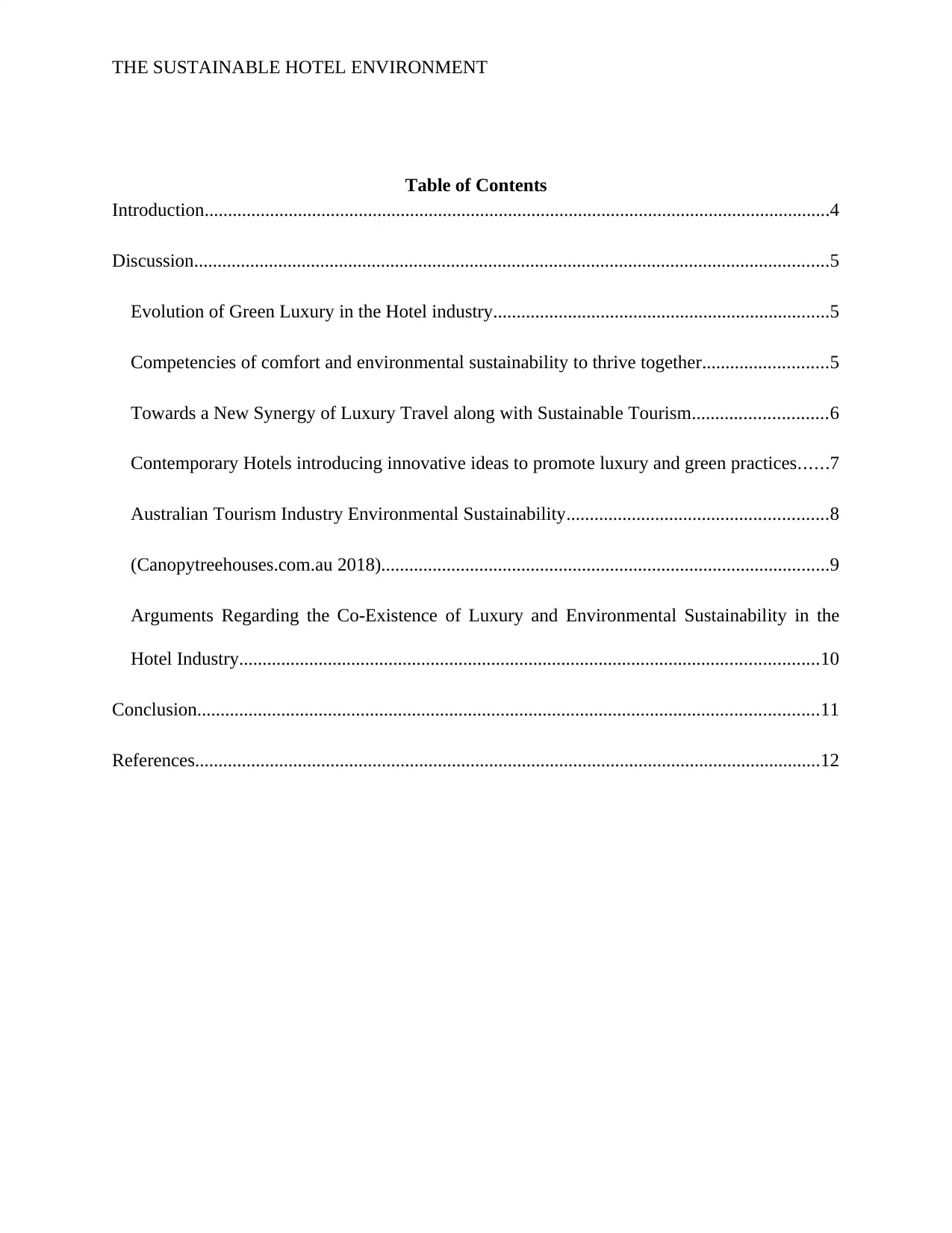
THE SUSTAINABLE HOTEL ENVIRONMENT
Table of Contents
Introduction......................................................................................................................................4
Discussion........................................................................................................................................5
Evolution of Green Luxury in the Hotel industry........................................................................5
Competencies of comfort and environmental sustainability to thrive together...........................5
Towards a New Synergy of Luxury Travel along with Sustainable Tourism.............................6
Contemporary Hotels introducing innovative ideas to promote luxury and green practices......7
Australian Tourism Industry Environmental Sustainability........................................................8
(Canopytreehouses.com.au 2018)................................................................................................9
Arguments Regarding the Co-Existence of Luxury and Environmental Sustainability in the
Hotel Industry............................................................................................................................10
Conclusion.....................................................................................................................................11
References......................................................................................................................................12
Table of Contents
Introduction......................................................................................................................................4
Discussion........................................................................................................................................5
Evolution of Green Luxury in the Hotel industry........................................................................5
Competencies of comfort and environmental sustainability to thrive together...........................5
Towards a New Synergy of Luxury Travel along with Sustainable Tourism.............................6
Contemporary Hotels introducing innovative ideas to promote luxury and green practices......7
Australian Tourism Industry Environmental Sustainability........................................................8
(Canopytreehouses.com.au 2018)................................................................................................9
Arguments Regarding the Co-Existence of Luxury and Environmental Sustainability in the
Hotel Industry............................................................................................................................10
Conclusion.....................................................................................................................................11
References......................................................................................................................................12
⊘ This is a preview!⊘
Do you want full access?
Subscribe today to unlock all pages.

Trusted by 1+ million students worldwide
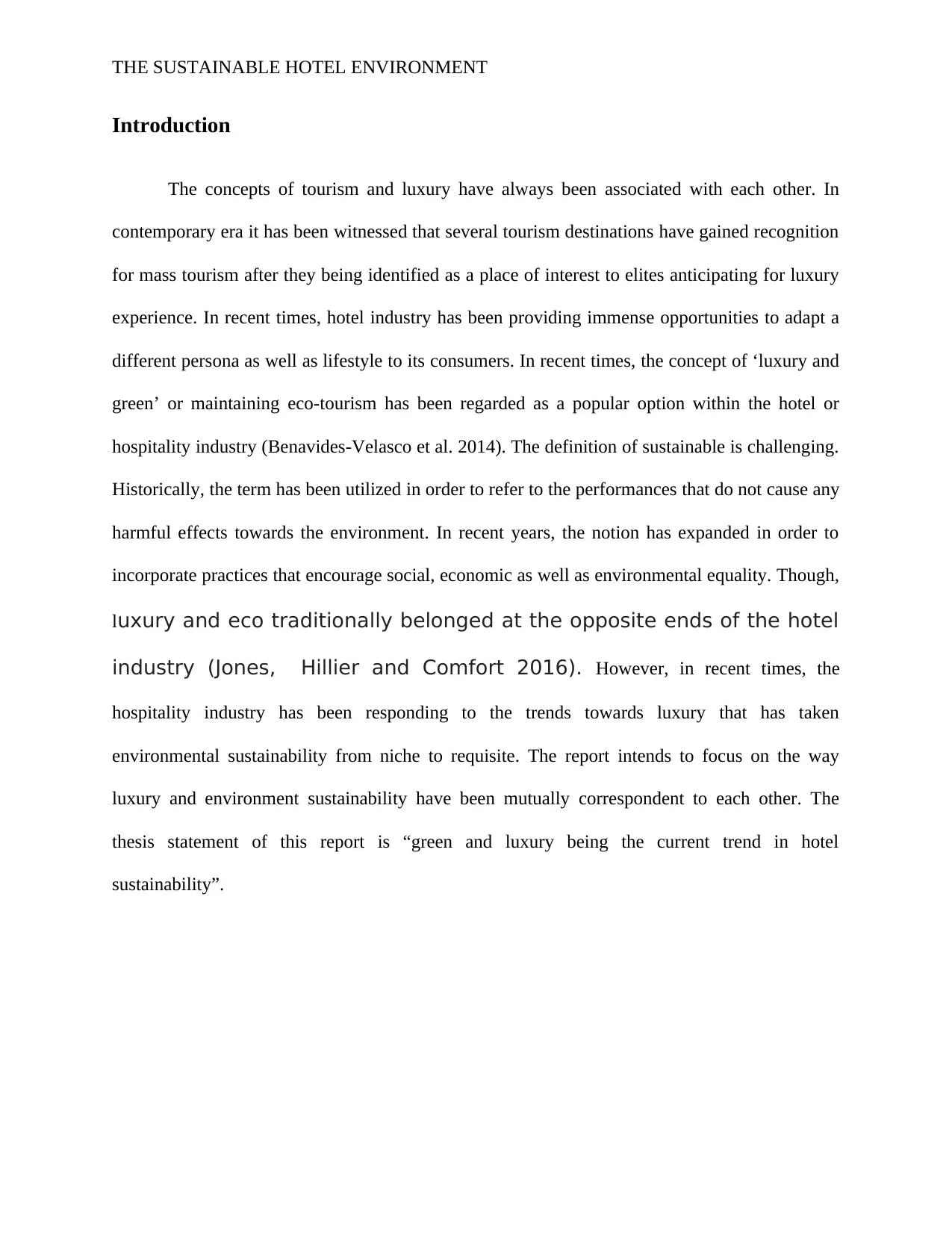
THE SUSTAINABLE HOTEL ENVIRONMENT
Introduction
The concepts of tourism and luxury have always been associated with each other. In
contemporary era it has been witnessed that several tourism destinations have gained recognition
for mass tourism after they being identified as a place of interest to elites anticipating for luxury
experience. In recent times, hotel industry has been providing immense opportunities to adapt a
different persona as well as lifestyle to its consumers. In recent times, the concept of ‘luxury and
green’ or maintaining eco-tourism has been regarded as a popular option within the hotel or
hospitality industry (Benavides-Velasco et al. 2014). The definition of sustainable is challenging.
Historically, the term has been utilized in order to refer to the performances that do not cause any
harmful effects towards the environment. In recent years, the notion has expanded in order to
incorporate practices that encourage social, economic as well as environmental equality. Though,
luxury and eco traditionally belonged at the opposite ends of the hotel
industry (Jones, Hillier and Comfort 2016). However, in recent times, the
hospitality industry has been responding to the trends towards luxury that has taken
environmental sustainability from niche to requisite. The report intends to focus on the way
luxury and environment sustainability have been mutually correspondent to each other. The
thesis statement of this report is “green and luxury being the current trend in hotel
sustainability”.
Introduction
The concepts of tourism and luxury have always been associated with each other. In
contemporary era it has been witnessed that several tourism destinations have gained recognition
for mass tourism after they being identified as a place of interest to elites anticipating for luxury
experience. In recent times, hotel industry has been providing immense opportunities to adapt a
different persona as well as lifestyle to its consumers. In recent times, the concept of ‘luxury and
green’ or maintaining eco-tourism has been regarded as a popular option within the hotel or
hospitality industry (Benavides-Velasco et al. 2014). The definition of sustainable is challenging.
Historically, the term has been utilized in order to refer to the performances that do not cause any
harmful effects towards the environment. In recent years, the notion has expanded in order to
incorporate practices that encourage social, economic as well as environmental equality. Though,
luxury and eco traditionally belonged at the opposite ends of the hotel
industry (Jones, Hillier and Comfort 2016). However, in recent times, the
hospitality industry has been responding to the trends towards luxury that has taken
environmental sustainability from niche to requisite. The report intends to focus on the way
luxury and environment sustainability have been mutually correspondent to each other. The
thesis statement of this report is “green and luxury being the current trend in hotel
sustainability”.
Paraphrase This Document
Need a fresh take? Get an instant paraphrase of this document with our AI Paraphraser
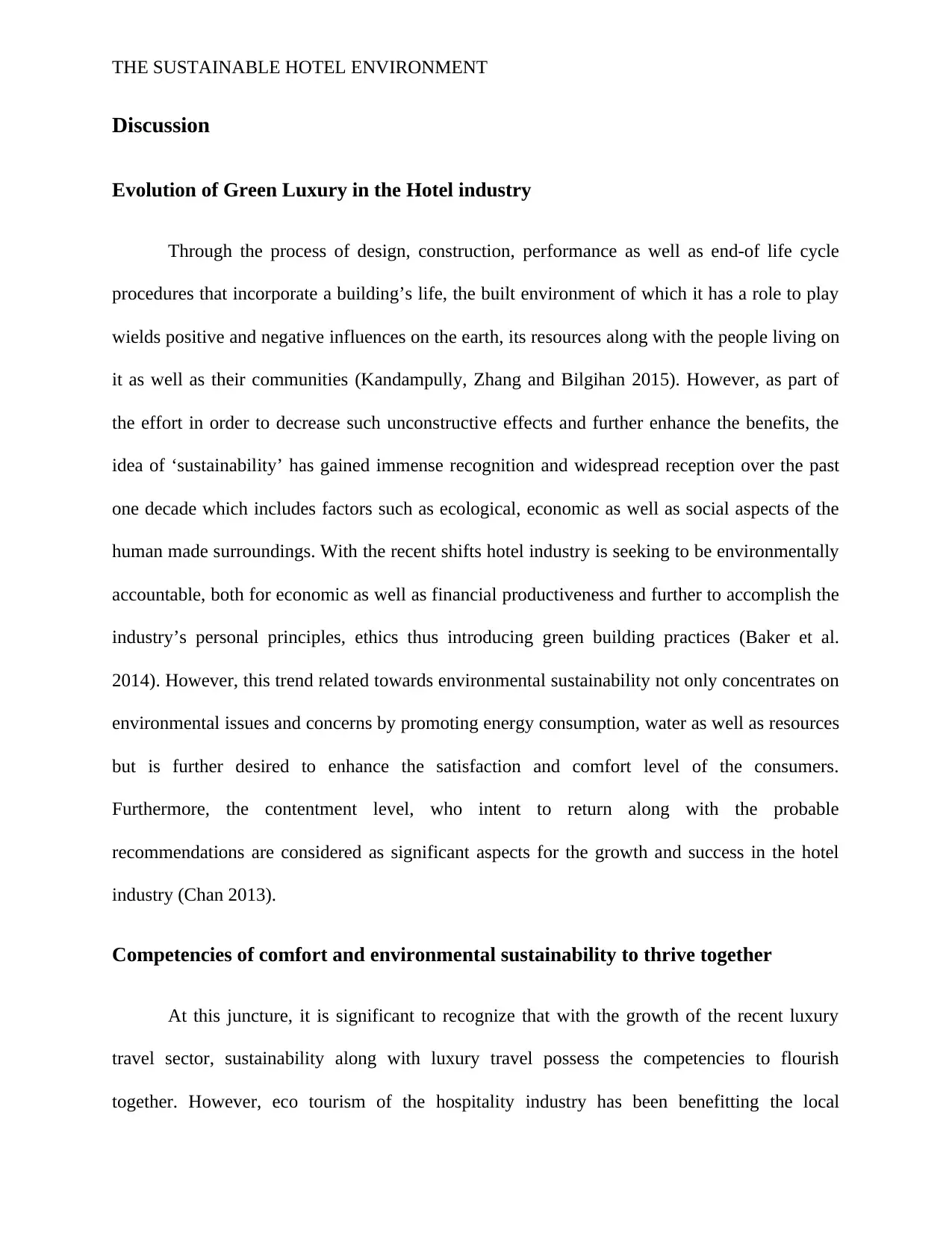
THE SUSTAINABLE HOTEL ENVIRONMENT
Discussion
Evolution of Green Luxury in the Hotel industry
Through the process of design, construction, performance as well as end-of life cycle
procedures that incorporate a building’s life, the built environment of which it has a role to play
wields positive and negative influences on the earth, its resources along with the people living on
it as well as their communities (Kandampully, Zhang and Bilgihan 2015). However, as part of
the effort in order to decrease such unconstructive effects and further enhance the benefits, the
idea of ‘sustainability’ has gained immense recognition and widespread reception over the past
one decade which includes factors such as ecological, economic as well as social aspects of the
human made surroundings. With the recent shifts hotel industry is seeking to be environmentally
accountable, both for economic as well as financial productiveness and further to accomplish the
industry’s personal principles, ethics thus introducing green building practices (Baker et al.
2014). However, this trend related towards environmental sustainability not only concentrates on
environmental issues and concerns by promoting energy consumption, water as well as resources
but is further desired to enhance the satisfaction and comfort level of the consumers.
Furthermore, the contentment level, who intent to return along with the probable
recommendations are considered as significant aspects for the growth and success in the hotel
industry (Chan 2013).
Competencies of comfort and environmental sustainability to thrive together
At this juncture, it is significant to recognize that with the growth of the recent luxury
travel sector, sustainability along with luxury travel possess the competencies to flourish
together. However, eco tourism of the hospitality industry has been benefitting the local
Discussion
Evolution of Green Luxury in the Hotel industry
Through the process of design, construction, performance as well as end-of life cycle
procedures that incorporate a building’s life, the built environment of which it has a role to play
wields positive and negative influences on the earth, its resources along with the people living on
it as well as their communities (Kandampully, Zhang and Bilgihan 2015). However, as part of
the effort in order to decrease such unconstructive effects and further enhance the benefits, the
idea of ‘sustainability’ has gained immense recognition and widespread reception over the past
one decade which includes factors such as ecological, economic as well as social aspects of the
human made surroundings. With the recent shifts hotel industry is seeking to be environmentally
accountable, both for economic as well as financial productiveness and further to accomplish the
industry’s personal principles, ethics thus introducing green building practices (Baker et al.
2014). However, this trend related towards environmental sustainability not only concentrates on
environmental issues and concerns by promoting energy consumption, water as well as resources
but is further desired to enhance the satisfaction and comfort level of the consumers.
Furthermore, the contentment level, who intent to return along with the probable
recommendations are considered as significant aspects for the growth and success in the hotel
industry (Chan 2013).
Competencies of comfort and environmental sustainability to thrive together
At this juncture, it is significant to recognize that with the growth of the recent luxury
travel sector, sustainability along with luxury travel possess the competencies to flourish
together. However, eco tourism of the hospitality industry has been benefitting the local
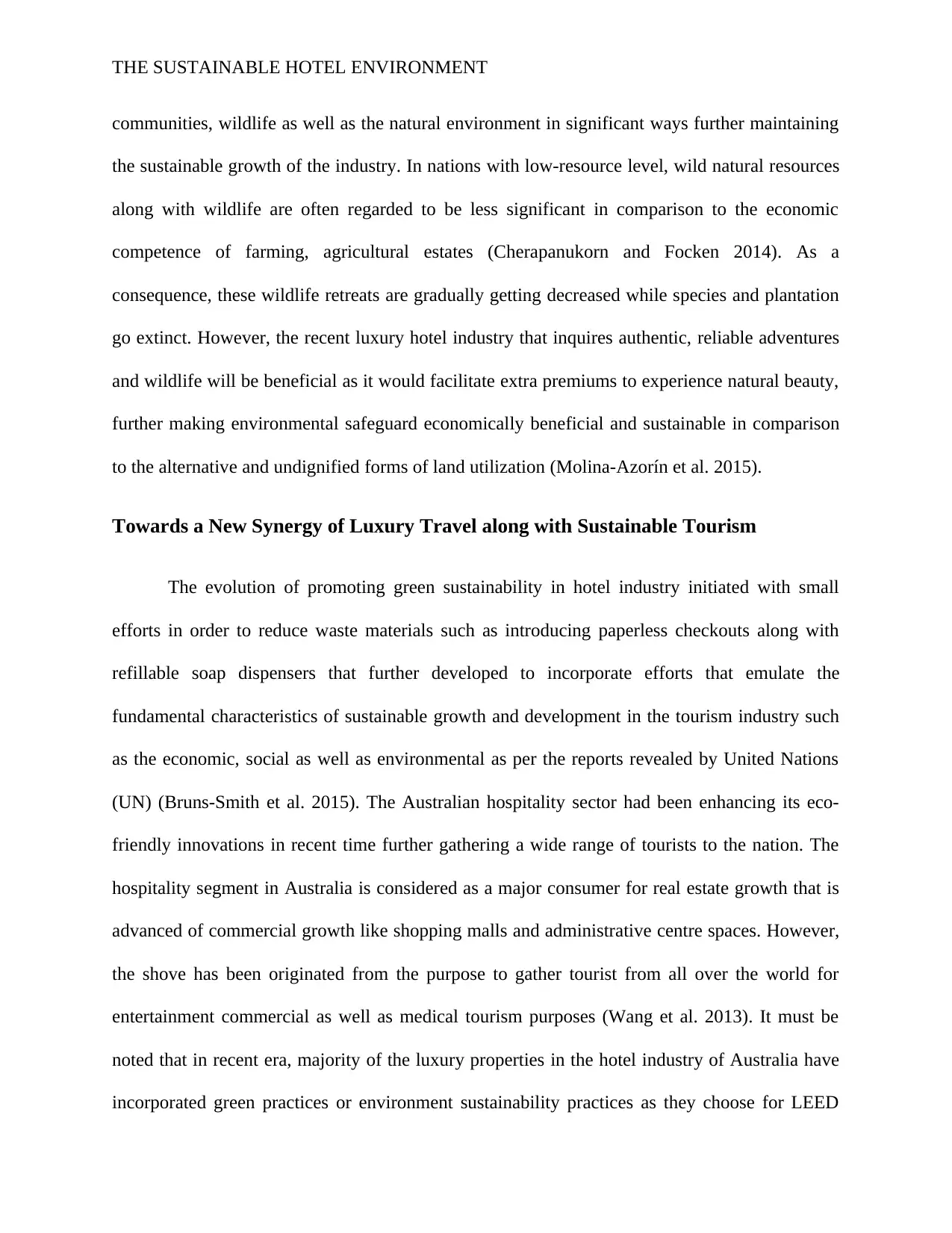
THE SUSTAINABLE HOTEL ENVIRONMENT
communities, wildlife as well as the natural environment in significant ways further maintaining
the sustainable growth of the industry. In nations with low-resource level, wild natural resources
along with wildlife are often regarded to be less significant in comparison to the economic
competence of farming, agricultural estates (Cherapanukorn and Focken 2014). As a
consequence, these wildlife retreats are gradually getting decreased while species and plantation
go extinct. However, the recent luxury hotel industry that inquires authentic, reliable adventures
and wildlife will be beneficial as it would facilitate extra premiums to experience natural beauty,
further making environmental safeguard economically beneficial and sustainable in comparison
to the alternative and undignified forms of land utilization (Molina-Azorín et al. 2015).
Towards a New Synergy of Luxury Travel along with Sustainable Tourism
The evolution of promoting green sustainability in hotel industry initiated with small
efforts in order to reduce waste materials such as introducing paperless checkouts along with
refillable soap dispensers that further developed to incorporate efforts that emulate the
fundamental characteristics of sustainable growth and development in the tourism industry such
as the economic, social as well as environmental as per the reports revealed by United Nations
(UN) (Bruns-Smith et al. 2015). The Australian hospitality sector had been enhancing its eco-
friendly innovations in recent time further gathering a wide range of tourists to the nation. The
hospitality segment in Australia is considered as a major consumer for real estate growth that is
advanced of commercial growth like shopping malls and administrative centre spaces. However,
the shove has been originated from the purpose to gather tourist from all over the world for
entertainment commercial as well as medical tourism purposes (Wang et al. 2013). It must be
noted that in recent era, majority of the luxury properties in the hotel industry of Australia have
incorporated green practices or environment sustainability practices as they choose for LEED
communities, wildlife as well as the natural environment in significant ways further maintaining
the sustainable growth of the industry. In nations with low-resource level, wild natural resources
along with wildlife are often regarded to be less significant in comparison to the economic
competence of farming, agricultural estates (Cherapanukorn and Focken 2014). As a
consequence, these wildlife retreats are gradually getting decreased while species and plantation
go extinct. However, the recent luxury hotel industry that inquires authentic, reliable adventures
and wildlife will be beneficial as it would facilitate extra premiums to experience natural beauty,
further making environmental safeguard economically beneficial and sustainable in comparison
to the alternative and undignified forms of land utilization (Molina-Azorín et al. 2015).
Towards a New Synergy of Luxury Travel along with Sustainable Tourism
The evolution of promoting green sustainability in hotel industry initiated with small
efforts in order to reduce waste materials such as introducing paperless checkouts along with
refillable soap dispensers that further developed to incorporate efforts that emulate the
fundamental characteristics of sustainable growth and development in the tourism industry such
as the economic, social as well as environmental as per the reports revealed by United Nations
(UN) (Bruns-Smith et al. 2015). The Australian hospitality sector had been enhancing its eco-
friendly innovations in recent time further gathering a wide range of tourists to the nation. The
hospitality segment in Australia is considered as a major consumer for real estate growth that is
advanced of commercial growth like shopping malls and administrative centre spaces. However,
the shove has been originated from the purpose to gather tourist from all over the world for
entertainment commercial as well as medical tourism purposes (Wang et al. 2013). It must be
noted that in recent era, majority of the luxury properties in the hotel industry of Australia have
incorporated green practices or environment sustainability practices as they choose for LEED
⊘ This is a preview!⊘
Do you want full access?
Subscribe today to unlock all pages.

Trusted by 1+ million students worldwide
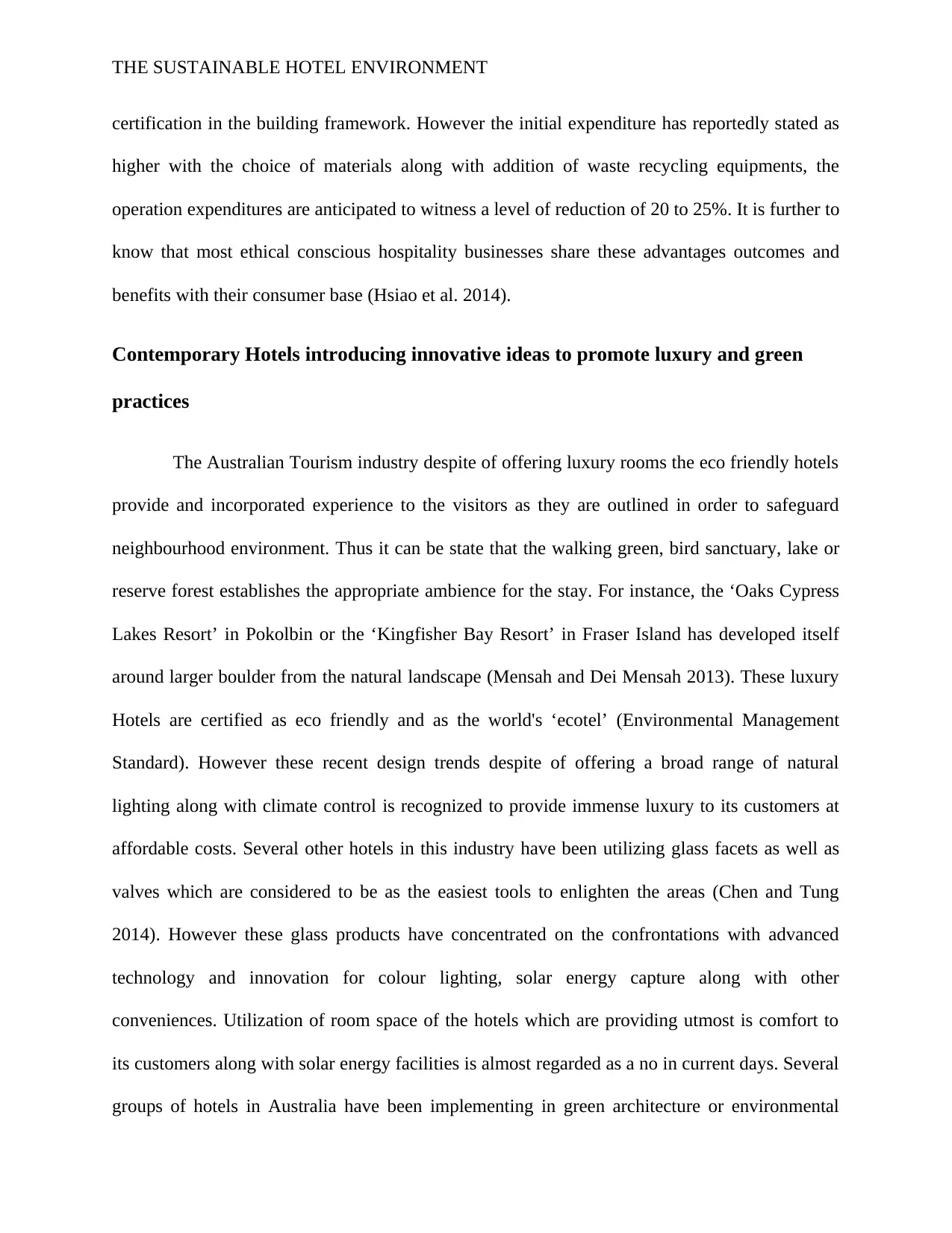
THE SUSTAINABLE HOTEL ENVIRONMENT
certification in the building framework. However the initial expenditure has reportedly stated as
higher with the choice of materials along with addition of waste recycling equipments, the
operation expenditures are anticipated to witness a level of reduction of 20 to 25%. It is further to
know that most ethical conscious hospitality businesses share these advantages outcomes and
benefits with their consumer base (Hsiao et al. 2014).
Contemporary Hotels introducing innovative ideas to promote luxury and green
practices
The Australian Tourism industry despite of offering luxury rooms the eco friendly hotels
provide and incorporated experience to the visitors as they are outlined in order to safeguard
neighbourhood environment. Thus it can be state that the walking green, bird sanctuary, lake or
reserve forest establishes the appropriate ambience for the stay. For instance, the ‘Oaks Cypress
Lakes Resort’ in Pokolbin or the ‘Kingfisher Bay Resort’ in Fraser Island has developed itself
around larger boulder from the natural landscape (Mensah and Dei Mensah 2013). These luxury
Hotels are certified as eco friendly and as the world's ‘ecotel’ (Environmental Management
Standard). However these recent design trends despite of offering a broad range of natural
lighting along with climate control is recognized to provide immense luxury to its customers at
affordable costs. Several other hotels in this industry have been utilizing glass facets as well as
valves which are considered to be as the easiest tools to enlighten the areas (Chen and Tung
2014). However these glass products have concentrated on the confrontations with advanced
technology and innovation for colour lighting, solar energy capture along with other
conveniences. Utilization of room space of the hotels which are providing utmost is comfort to
its customers along with solar energy facilities is almost regarded as a no in current days. Several
groups of hotels in Australia have been implementing in green architecture or environmental
certification in the building framework. However the initial expenditure has reportedly stated as
higher with the choice of materials along with addition of waste recycling equipments, the
operation expenditures are anticipated to witness a level of reduction of 20 to 25%. It is further to
know that most ethical conscious hospitality businesses share these advantages outcomes and
benefits with their consumer base (Hsiao et al. 2014).
Contemporary Hotels introducing innovative ideas to promote luxury and green
practices
The Australian Tourism industry despite of offering luxury rooms the eco friendly hotels
provide and incorporated experience to the visitors as they are outlined in order to safeguard
neighbourhood environment. Thus it can be state that the walking green, bird sanctuary, lake or
reserve forest establishes the appropriate ambience for the stay. For instance, the ‘Oaks Cypress
Lakes Resort’ in Pokolbin or the ‘Kingfisher Bay Resort’ in Fraser Island has developed itself
around larger boulder from the natural landscape (Mensah and Dei Mensah 2013). These luxury
Hotels are certified as eco friendly and as the world's ‘ecotel’ (Environmental Management
Standard). However these recent design trends despite of offering a broad range of natural
lighting along with climate control is recognized to provide immense luxury to its customers at
affordable costs. Several other hotels in this industry have been utilizing glass facets as well as
valves which are considered to be as the easiest tools to enlighten the areas (Chen and Tung
2014). However these glass products have concentrated on the confrontations with advanced
technology and innovation for colour lighting, solar energy capture along with other
conveniences. Utilization of room space of the hotels which are providing utmost is comfort to
its customers along with solar energy facilities is almost regarded as a no in current days. Several
groups of hotels in Australia have been implementing in green architecture or environmental
Paraphrase This Document
Need a fresh take? Get an instant paraphrase of this document with our AI Paraphraser
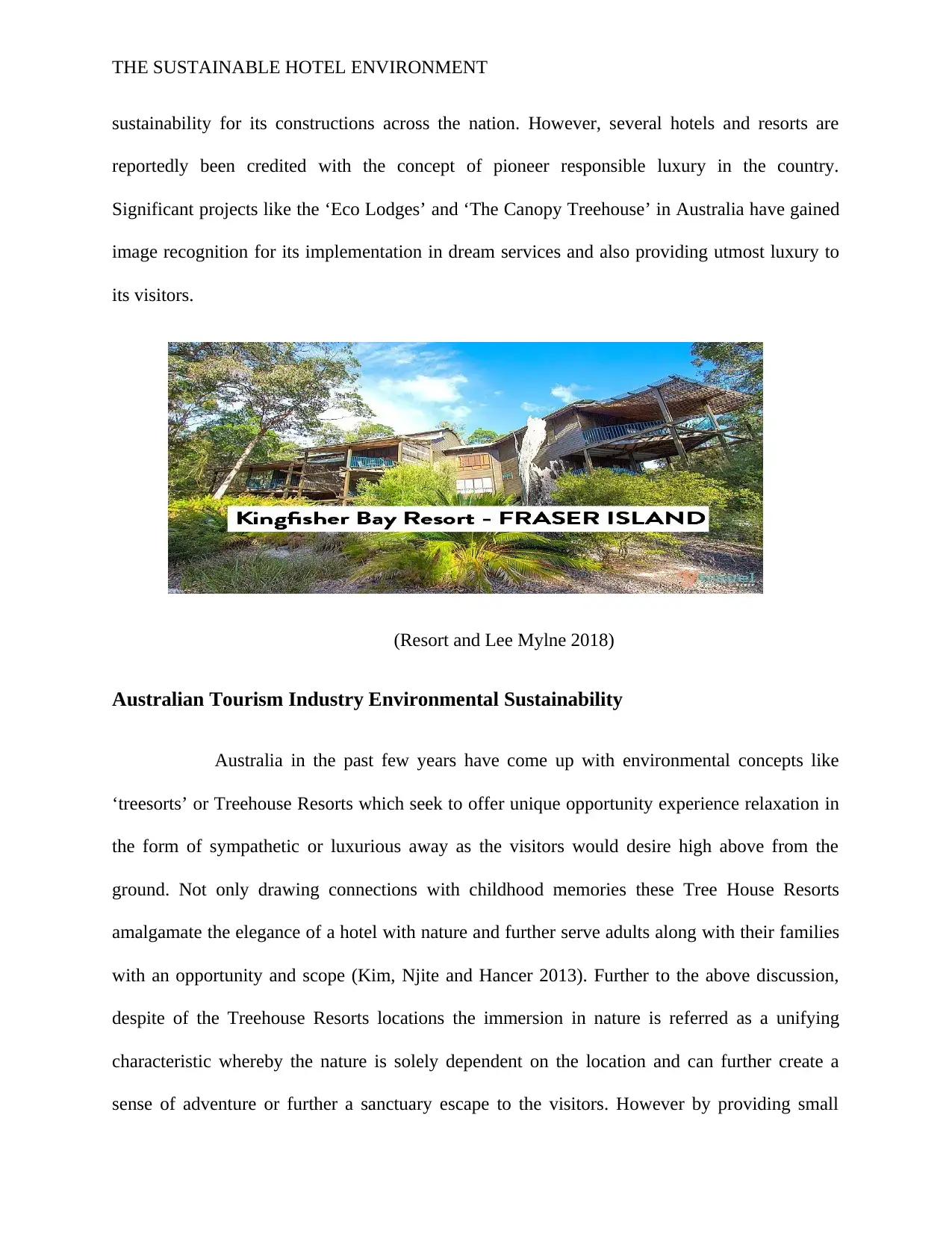
THE SUSTAINABLE HOTEL ENVIRONMENT
sustainability for its constructions across the nation. However, several hotels and resorts are
reportedly been credited with the concept of pioneer responsible luxury in the country.
Significant projects like the ‘Eco Lodges’ and ‘The Canopy Treehouse’ in Australia have gained
image recognition for its implementation in dream services and also providing utmost luxury to
its visitors.
(Resort and Lee Mylne 2018)
Australian Tourism Industry Environmental Sustainability
Australia in the past few years have come up with environmental concepts like
‘treesorts’ or Treehouse Resorts which seek to offer unique opportunity experience relaxation in
the form of sympathetic or luxurious away as the visitors would desire high above from the
ground. Not only drawing connections with childhood memories these Tree House Resorts
amalgamate the elegance of a hotel with nature and further serve adults along with their families
with an opportunity and scope (Kim, Njite and Hancer 2013). Further to the above discussion,
despite of the Treehouse Resorts locations the immersion in nature is referred as a unifying
characteristic whereby the nature is solely dependent on the location and can further create a
sense of adventure or further a sanctuary escape to the visitors. However by providing small
sustainability for its constructions across the nation. However, several hotels and resorts are
reportedly been credited with the concept of pioneer responsible luxury in the country.
Significant projects like the ‘Eco Lodges’ and ‘The Canopy Treehouse’ in Australia have gained
image recognition for its implementation in dream services and also providing utmost luxury to
its visitors.
(Resort and Lee Mylne 2018)
Australian Tourism Industry Environmental Sustainability
Australia in the past few years have come up with environmental concepts like
‘treesorts’ or Treehouse Resorts which seek to offer unique opportunity experience relaxation in
the form of sympathetic or luxurious away as the visitors would desire high above from the
ground. Not only drawing connections with childhood memories these Tree House Resorts
amalgamate the elegance of a hotel with nature and further serve adults along with their families
with an opportunity and scope (Kim, Njite and Hancer 2013). Further to the above discussion,
despite of the Treehouse Resorts locations the immersion in nature is referred as a unifying
characteristic whereby the nature is solely dependent on the location and can further create a
sense of adventure or further a sanctuary escape to the visitors. However by providing small
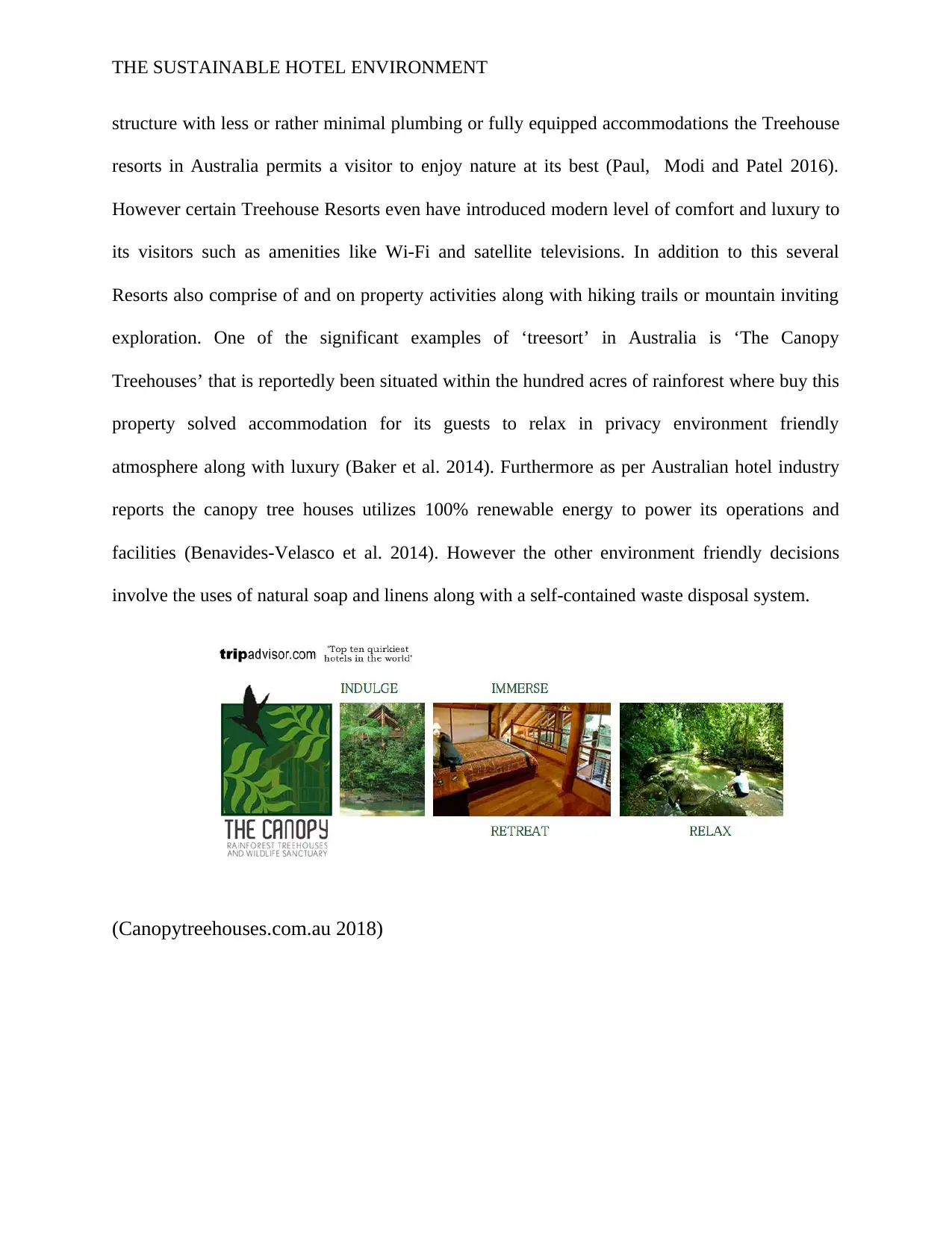
THE SUSTAINABLE HOTEL ENVIRONMENT
structure with less or rather minimal plumbing or fully equipped accommodations the Treehouse
resorts in Australia permits a visitor to enjoy nature at its best (Paul, Modi and Patel 2016).
However certain Treehouse Resorts even have introduced modern level of comfort and luxury to
its visitors such as amenities like Wi-Fi and satellite televisions. In addition to this several
Resorts also comprise of and on property activities along with hiking trails or mountain inviting
exploration. One of the significant examples of ‘treesort’ in Australia is ‘The Canopy
Treehouses’ that is reportedly been situated within the hundred acres of rainforest where buy this
property solved accommodation for its guests to relax in privacy environment friendly
atmosphere along with luxury (Baker et al. 2014). Furthermore as per Australian hotel industry
reports the canopy tree houses utilizes 100% renewable energy to power its operations and
facilities (Benavides-Velasco et al. 2014). However the other environment friendly decisions
involve the uses of natural soap and linens along with a self-contained waste disposal system.
(Canopytreehouses.com.au 2018)
structure with less or rather minimal plumbing or fully equipped accommodations the Treehouse
resorts in Australia permits a visitor to enjoy nature at its best (Paul, Modi and Patel 2016).
However certain Treehouse Resorts even have introduced modern level of comfort and luxury to
its visitors such as amenities like Wi-Fi and satellite televisions. In addition to this several
Resorts also comprise of and on property activities along with hiking trails or mountain inviting
exploration. One of the significant examples of ‘treesort’ in Australia is ‘The Canopy
Treehouses’ that is reportedly been situated within the hundred acres of rainforest where buy this
property solved accommodation for its guests to relax in privacy environment friendly
atmosphere along with luxury (Baker et al. 2014). Furthermore as per Australian hotel industry
reports the canopy tree houses utilizes 100% renewable energy to power its operations and
facilities (Benavides-Velasco et al. 2014). However the other environment friendly decisions
involve the uses of natural soap and linens along with a self-contained waste disposal system.
(Canopytreehouses.com.au 2018)
⊘ This is a preview!⊘
Do you want full access?
Subscribe today to unlock all pages.

Trusted by 1+ million students worldwide
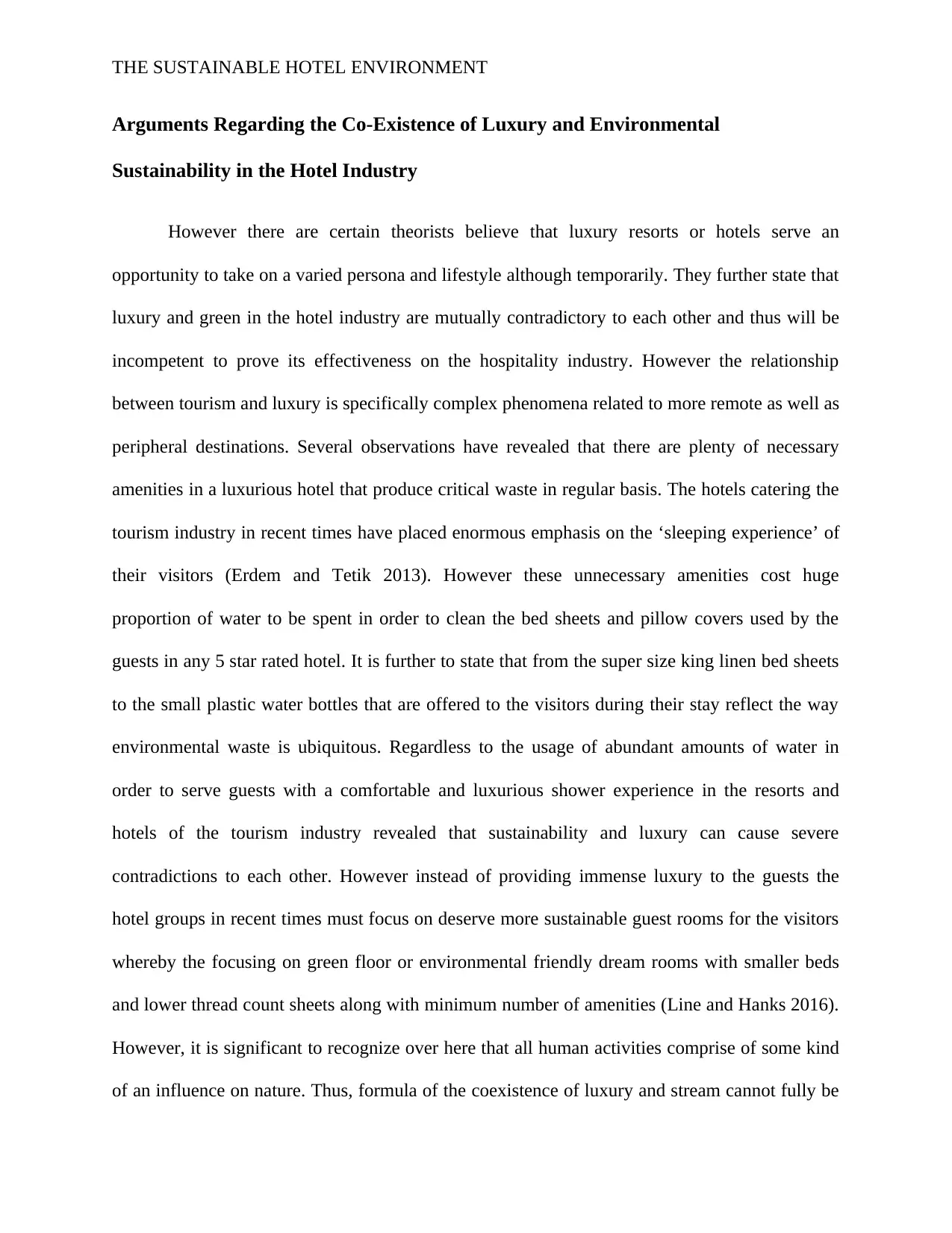
THE SUSTAINABLE HOTEL ENVIRONMENT
Arguments Regarding the Co-Existence of Luxury and Environmental
Sustainability in the Hotel Industry
However there are certain theorists believe that luxury resorts or hotels serve an
opportunity to take on a varied persona and lifestyle although temporarily. They further state that
luxury and green in the hotel industry are mutually contradictory to each other and thus will be
incompetent to prove its effectiveness on the hospitality industry. However the relationship
between tourism and luxury is specifically complex phenomena related to more remote as well as
peripheral destinations. Several observations have revealed that there are plenty of necessary
amenities in a luxurious hotel that produce critical waste in regular basis. The hotels catering the
tourism industry in recent times have placed enormous emphasis on the ‘sleeping experience’ of
their visitors (Erdem and Tetik 2013). However these unnecessary amenities cost huge
proportion of water to be spent in order to clean the bed sheets and pillow covers used by the
guests in any 5 star rated hotel. It is further to state that from the super size king linen bed sheets
to the small plastic water bottles that are offered to the visitors during their stay reflect the way
environmental waste is ubiquitous. Regardless to the usage of abundant amounts of water in
order to serve guests with a comfortable and luxurious shower experience in the resorts and
hotels of the tourism industry revealed that sustainability and luxury can cause severe
contradictions to each other. However instead of providing immense luxury to the guests the
hotel groups in recent times must focus on deserve more sustainable guest rooms for the visitors
whereby the focusing on green floor or environmental friendly dream rooms with smaller beds
and lower thread count sheets along with minimum number of amenities (Line and Hanks 2016).
However, it is significant to recognize over here that all human activities comprise of some kind
of an influence on nature. Thus, formula of the coexistence of luxury and stream cannot fully be
Arguments Regarding the Co-Existence of Luxury and Environmental
Sustainability in the Hotel Industry
However there are certain theorists believe that luxury resorts or hotels serve an
opportunity to take on a varied persona and lifestyle although temporarily. They further state that
luxury and green in the hotel industry are mutually contradictory to each other and thus will be
incompetent to prove its effectiveness on the hospitality industry. However the relationship
between tourism and luxury is specifically complex phenomena related to more remote as well as
peripheral destinations. Several observations have revealed that there are plenty of necessary
amenities in a luxurious hotel that produce critical waste in regular basis. The hotels catering the
tourism industry in recent times have placed enormous emphasis on the ‘sleeping experience’ of
their visitors (Erdem and Tetik 2013). However these unnecessary amenities cost huge
proportion of water to be spent in order to clean the bed sheets and pillow covers used by the
guests in any 5 star rated hotel. It is further to state that from the super size king linen bed sheets
to the small plastic water bottles that are offered to the visitors during their stay reflect the way
environmental waste is ubiquitous. Regardless to the usage of abundant amounts of water in
order to serve guests with a comfortable and luxurious shower experience in the resorts and
hotels of the tourism industry revealed that sustainability and luxury can cause severe
contradictions to each other. However instead of providing immense luxury to the guests the
hotel groups in recent times must focus on deserve more sustainable guest rooms for the visitors
whereby the focusing on green floor or environmental friendly dream rooms with smaller beds
and lower thread count sheets along with minimum number of amenities (Line and Hanks 2016).
However, it is significant to recognize over here that all human activities comprise of some kind
of an influence on nature. Thus, formula of the coexistence of luxury and stream cannot fully be
Paraphrase This Document
Need a fresh take? Get an instant paraphrase of this document with our AI Paraphraser
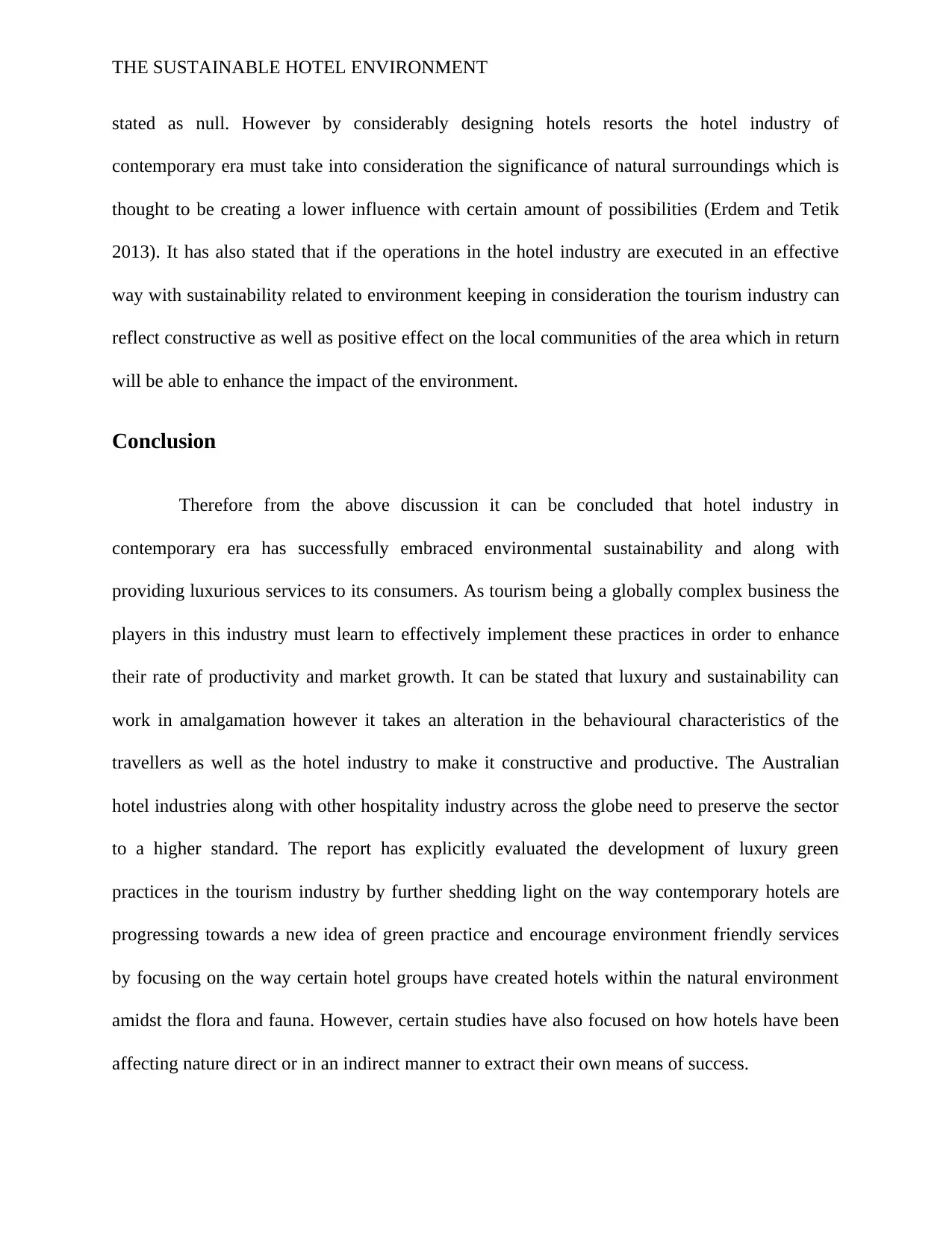
THE SUSTAINABLE HOTEL ENVIRONMENT
stated as null. However by considerably designing hotels resorts the hotel industry of
contemporary era must take into consideration the significance of natural surroundings which is
thought to be creating a lower influence with certain amount of possibilities (Erdem and Tetik
2013). It has also stated that if the operations in the hotel industry are executed in an effective
way with sustainability related to environment keeping in consideration the tourism industry can
reflect constructive as well as positive effect on the local communities of the area which in return
will be able to enhance the impact of the environment.
Conclusion
Therefore from the above discussion it can be concluded that hotel industry in
contemporary era has successfully embraced environmental sustainability and along with
providing luxurious services to its consumers. As tourism being a globally complex business the
players in this industry must learn to effectively implement these practices in order to enhance
their rate of productivity and market growth. It can be stated that luxury and sustainability can
work in amalgamation however it takes an alteration in the behavioural characteristics of the
travellers as well as the hotel industry to make it constructive and productive. The Australian
hotel industries along with other hospitality industry across the globe need to preserve the sector
to a higher standard. The report has explicitly evaluated the development of luxury green
practices in the tourism industry by further shedding light on the way contemporary hotels are
progressing towards a new idea of green practice and encourage environment friendly services
by focusing on the way certain hotel groups have created hotels within the natural environment
amidst the flora and fauna. However, certain studies have also focused on how hotels have been
affecting nature direct or in an indirect manner to extract their own means of success.
stated as null. However by considerably designing hotels resorts the hotel industry of
contemporary era must take into consideration the significance of natural surroundings which is
thought to be creating a lower influence with certain amount of possibilities (Erdem and Tetik
2013). It has also stated that if the operations in the hotel industry are executed in an effective
way with sustainability related to environment keeping in consideration the tourism industry can
reflect constructive as well as positive effect on the local communities of the area which in return
will be able to enhance the impact of the environment.
Conclusion
Therefore from the above discussion it can be concluded that hotel industry in
contemporary era has successfully embraced environmental sustainability and along with
providing luxurious services to its consumers. As tourism being a globally complex business the
players in this industry must learn to effectively implement these practices in order to enhance
their rate of productivity and market growth. It can be stated that luxury and sustainability can
work in amalgamation however it takes an alteration in the behavioural characteristics of the
travellers as well as the hotel industry to make it constructive and productive. The Australian
hotel industries along with other hospitality industry across the globe need to preserve the sector
to a higher standard. The report has explicitly evaluated the development of luxury green
practices in the tourism industry by further shedding light on the way contemporary hotels are
progressing towards a new idea of green practice and encourage environment friendly services
by focusing on the way certain hotel groups have created hotels within the natural environment
amidst the flora and fauna. However, certain studies have also focused on how hotels have been
affecting nature direct or in an indirect manner to extract their own means of success.
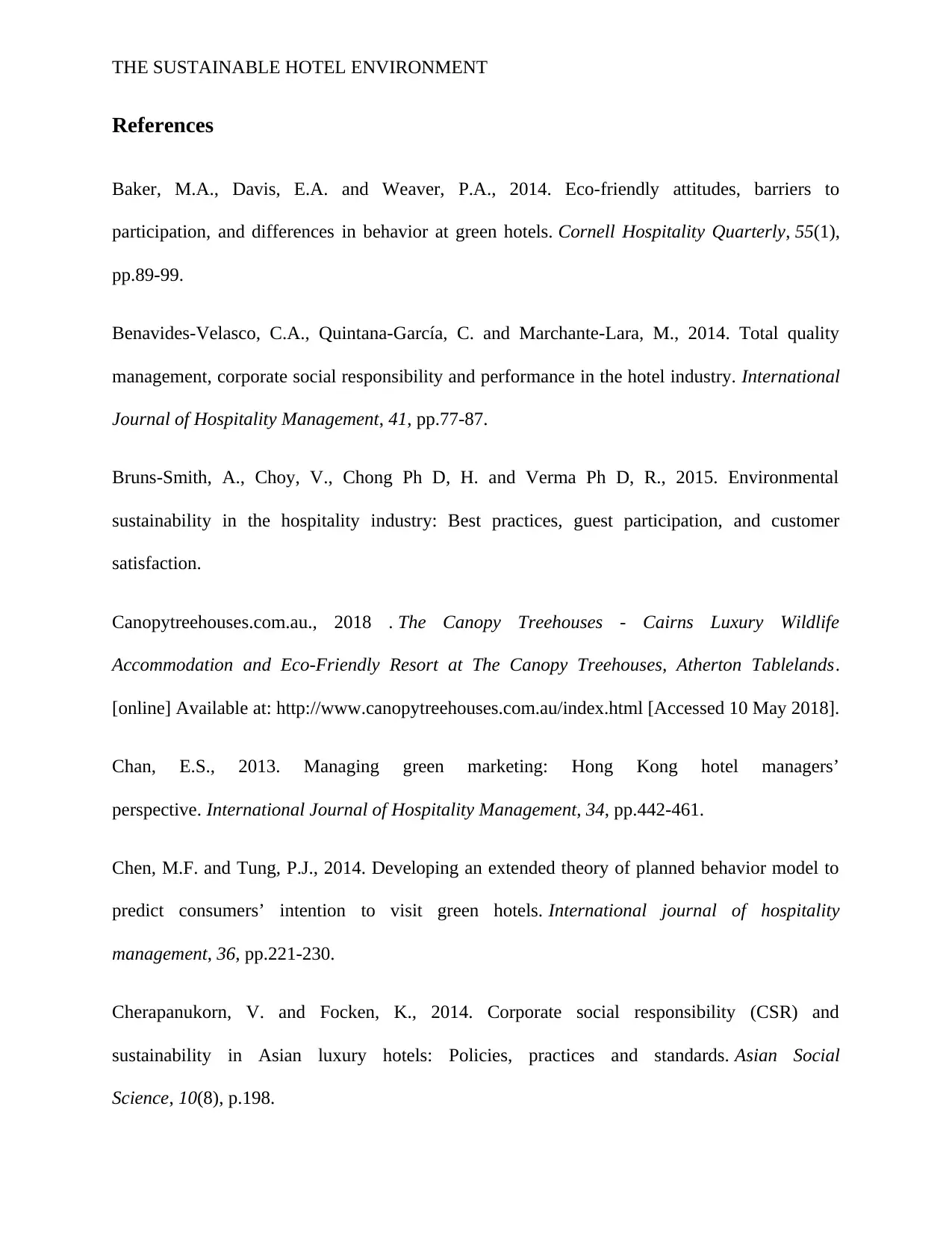
THE SUSTAINABLE HOTEL ENVIRONMENT
References
Baker, M.A., Davis, E.A. and Weaver, P.A., 2014. Eco-friendly attitudes, barriers to
participation, and differences in behavior at green hotels. Cornell Hospitality Quarterly, 55(1),
pp.89-99.
Benavides-Velasco, C.A., Quintana-García, C. and Marchante-Lara, M., 2014. Total quality
management, corporate social responsibility and performance in the hotel industry. International
Journal of Hospitality Management, 41, pp.77-87.
Bruns-Smith, A., Choy, V., Chong Ph D, H. and Verma Ph D, R., 2015. Environmental
sustainability in the hospitality industry: Best practices, guest participation, and customer
satisfaction.
Canopytreehouses.com.au., 2018 . The Canopy Treehouses - Cairns Luxury Wildlife
Accommodation and Eco-Friendly Resort at The Canopy Treehouses, Atherton Tablelands.
[online] Available at: http://www.canopytreehouses.com.au/index.html [Accessed 10 May 2018].
Chan, E.S., 2013. Managing green marketing: Hong Kong hotel managers’
perspective. International Journal of Hospitality Management, 34, pp.442-461.
Chen, M.F. and Tung, P.J., 2014. Developing an extended theory of planned behavior model to
predict consumers’ intention to visit green hotels. International journal of hospitality
management, 36, pp.221-230.
Cherapanukorn, V. and Focken, K., 2014. Corporate social responsibility (CSR) and
sustainability in Asian luxury hotels: Policies, practices and standards. Asian Social
Science, 10(8), p.198.
References
Baker, M.A., Davis, E.A. and Weaver, P.A., 2014. Eco-friendly attitudes, barriers to
participation, and differences in behavior at green hotels. Cornell Hospitality Quarterly, 55(1),
pp.89-99.
Benavides-Velasco, C.A., Quintana-García, C. and Marchante-Lara, M., 2014. Total quality
management, corporate social responsibility and performance in the hotel industry. International
Journal of Hospitality Management, 41, pp.77-87.
Bruns-Smith, A., Choy, V., Chong Ph D, H. and Verma Ph D, R., 2015. Environmental
sustainability in the hospitality industry: Best practices, guest participation, and customer
satisfaction.
Canopytreehouses.com.au., 2018 . The Canopy Treehouses - Cairns Luxury Wildlife
Accommodation and Eco-Friendly Resort at The Canopy Treehouses, Atherton Tablelands.
[online] Available at: http://www.canopytreehouses.com.au/index.html [Accessed 10 May 2018].
Chan, E.S., 2013. Managing green marketing: Hong Kong hotel managers’
perspective. International Journal of Hospitality Management, 34, pp.442-461.
Chen, M.F. and Tung, P.J., 2014. Developing an extended theory of planned behavior model to
predict consumers’ intention to visit green hotels. International journal of hospitality
management, 36, pp.221-230.
Cherapanukorn, V. and Focken, K., 2014. Corporate social responsibility (CSR) and
sustainability in Asian luxury hotels: Policies, practices and standards. Asian Social
Science, 10(8), p.198.
⊘ This is a preview!⊘
Do you want full access?
Subscribe today to unlock all pages.

Trusted by 1+ million students worldwide
1 out of 14
Related Documents
Your All-in-One AI-Powered Toolkit for Academic Success.
+13062052269
info@desklib.com
Available 24*7 on WhatsApp / Email
![[object Object]](/_next/static/media/star-bottom.7253800d.svg)
Unlock your academic potential
Copyright © 2020–2025 A2Z Services. All Rights Reserved. Developed and managed by ZUCOL.





